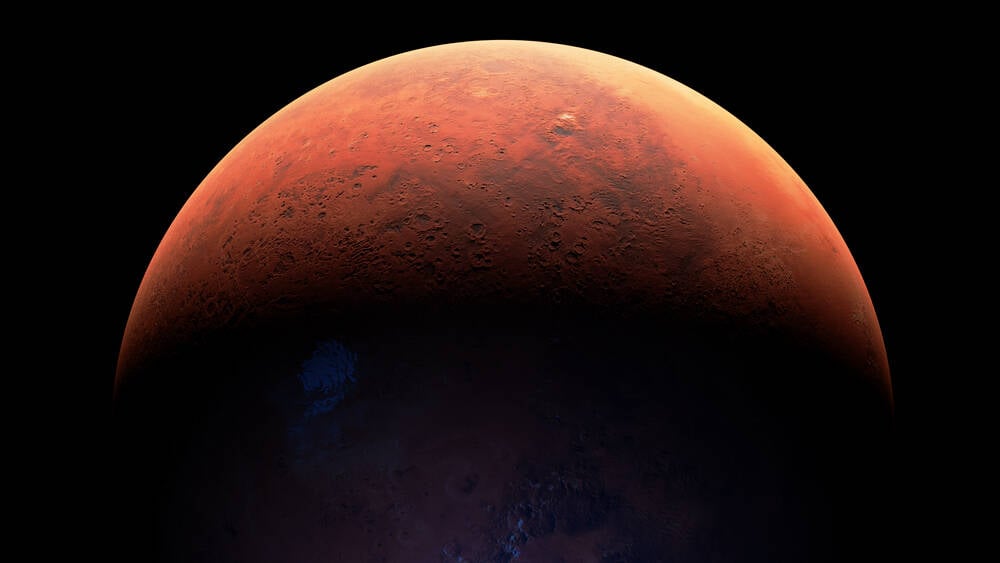Space Extenders II The Mars Express recorded the highest clouds ever seen above the surface of a planet, as well as water ice on Mars’ polar caps. And although the veteran spacecraft is now seemingly entering the final phase of its journey, this good thing isn’t coming to an end just yet.
By rights, the European Space Agency’s Mars Express (MEX) mission should be over. The engineers should be burning up what remains of the fuel to ensure the spacecraft – assembled in an era when planetary protection was not the consideration it is today – is destroyed in the Martian atmosphere.
However, the craft has continued its work. This is thanks, in part, to Japan’s plans for a sample return mission to one of Mars’s moons, Phobos.
December 25, 2023, marks two decades since MEX slipped into orbit around Mars. And shortly after comes the 20th anniversary of when the first images of the planet, snapped from orbit, were made public.
Speaking to The Register, ESA spacecraft operations manager James Godfrey tells us that scientists can look forward to a few more years of data but that wasn’t always the plan.
“We were only extended until the end of June this year,” he explains.
We’d imagined there’d be 10 nerds from their basements watching this, and we got a million views
The budget of ESA’s science directorate was stretched, and cuts needed to be made. Mars Express (MEX) does not represent a huge expense these days however it is an ongoing cost.
To celebrate MEX, ESA ran a livestream on June 2 consisting of images from MEX’s Visual Monitoring Camera (VMC).
“It was interesting,” says Godfrey. “We’d imagined there’d be 10 nerds from their basements watching this, and we got a million views…”
This writer was one of those nerds. There were some complaints about the quality and lack of “excitement,” though we’d highlight that VMC is – pretty much – on a par with an elderly webcam, and the first livestream from Mars is an accomplishment.
However, it wasn’t the popularity of the orbiter that secured another mission extension. Godfrey tells us that MEX has now been extended to the end of 2026 and provisionally as far as 2028 to support another mission.
“The Japanese are planning to launch the MMX [Martian Moons Explorer] mission,” says Godfrey, “and they were planning to launch in 2024, arriving at Mars in 2025.
“They intend to land on Phobos and do a sample return … the sample return was planned to come back to Earth in 2028, so that’s what gave us that timescale.”
However, as with many things to do with spaceflight, it is looking increasingly likely that MMX will be delayed due to the failure of Japan’s H3 rocket. This could result in MMX moving from a September 2024 launch to 2026 to hit Mars transfer windows.
Such a delay has implications for MEX. It’s one thing to keep the spacecraft operating into 2028. Going much beyond that will require some careful thought from the team.
“The three things that we are most concerned about,” says Godfrey, “are fuel, batteries, and gyros.”
Fuel is tricky since MEX is running on fumes at this point. With no way of measuring what is left, the team turned to the experience of Venus Express and used the moment when it ran out of fuel compared to estimates. “We take that as a benchmark,” Godfrey tells us, “it’s all we have.”
“We could run out of fuel tomorrow, we are flying a little bit on vapor and a wing and a prayer!”
MEX requires fuel for its thrusters. The reaction wheels need to be desaturated, and attitude maintained. It was launched with 595 kg in its two propellant tanks, and Godfrey reckons only a few kilograms remain. However, with the spacecraft sipping only 200 grams per year – assuming it doesn’t drop into any safe modes – there should be sufficient fuel to eke the mission out a little longer.
Once the fuel runs out, though, the mission will end.
In the meantime, scientists are reveling in the bonus data being returned from spacecraft. Godfrey says MEX is probably even slightly more productive than it was a decade ago. The latest tweak was to the software running behind the MARSIS ground penetrating radar. The final patch is expected as 2023 draws to a close.
“That’s very exciting because it will quadruple the length of time that they can do an observation,” Godfrey says.
“Also, the data are being stored in the flash memory of the instrument and not been put on the spacecraft bus. Prior to this, there were bus traffic issues, so we couldn’t run MARSIS in parallel with some of the other instruments. That issue goes away.”
Teaching an old dog new tricks, indeed.
However, it is unlikely MEX will make it to its 30th birthday. “The important thing,” laughs Godfrey, “is that we outlive Mars Odyssey … they want to outlive us. So there’s a bit of friendly competition.”
NASA’s Mars Odyssey orbiter arrived in orbit around Mars on October 24, 2001. As with MEX, engineers have been nervously monitoring the fuel level and estimate there is enough left to keep Odyssey running until 2025.
Although MEX can pick up some free delta-v when the thrusters are fired to desaturate the reaction wheels, “We haven’t got enough fuel to do anything dramatic,” Godfrey confirms.
A best-case scenario would be burning the rest of fuel to send MEX into the Martian atmosphere 60-70 years from now. However, with its mission extended, there is every chance that MEX will end up adrift unless enough fuel remains to tweak its orbit sufficiently. ®

Dr. Thomas Hughes is a UK-based scientist and science communicator who makes complex topics accessible to readers. His articles explore breakthroughs in various scientific disciplines, from space exploration to cutting-edge research.








